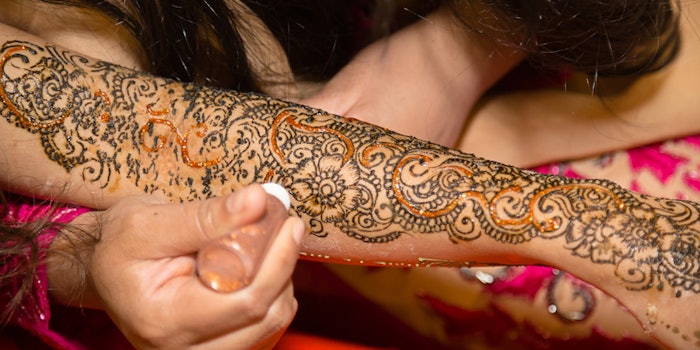
Temporary tattoos are all the rage—from rub-on kid party give-aways, to serious airbrush art and at-home kits "made to last." However, one type of temporary tattoo making infamous headlines is "black henna," especially in the eyes of the British Skin Foundation, which issued a flat-out warning against them. The U.S. Food and Drug Administration seconds this notion.
Para-phenylenediamine
According to the group, most "black henna" temporary tattoos (BHTT) are not actually based on henna, but the chemical para-phenylenediamine (PPD), which is found in hair dyes. Its use is not permitted for products that come into contact with skin in the European Union, as it can cause blistering and painful skin burns, and lead to scarring. It also can leave the user with a sensitivity for PPD, which increases their risk of a severe allergic reactions to hair dyes.
Henna Mechanism of Action
According to a 2011 article in Cosmetics & Toiletries (C&T), actual henna tattoos normally are safe. They involve exposing the skin externally to a henna tattoo mixture that contains ground henna leaves mixed with water or oil. The natural dye in henna leaves is 2-hydroxy-1,4-naphtoquinone (Lawsone), which reacts on the skin surface with skin proteins, leading to a temporary orange-brown coloring of the skin.
Natural henna tattoo mixture—i.e., without PPD, is applied using semi-conical containers to make it easier to achieve elaborate designs and is left on the skin for three to six hours. The longer the exposure time, the darker the final color, which is never black as is often assumed, but a dark orange-brown.
PPD Reaction
However, some manufacturers began adding PPD to henna tattoo mixtures to significantly reduce the application time and give a darker color. The autoxidation products of PPD including Bandrowski’s base, a trimer of PPD, are very strong potential skin sensitizers, thus the addition of PPD is responsible for most reported skin complications arising from the use of black henna. These include allergic contact dermatitis, post-inflammatory hyperpigmentation, or even worse, an allergic sensitization to PPD and the many substances that cross-react with it, including para-aminophenol, para-toluenediamine or many azoic dyes, such as disperse orange 3.
Testing for PPD
The article featured in C&T specifically discusses the colorimetric analysis for PPD in henna-based, non-permanent tattoo color mixtures. The advantage of the described assay is its ability to be quickly and easily performed as a screening analysis in the lab, as well as during on-site controls. For product developers and formulators in the lab, the assay is suggested for raw material checks or importation controls of henna plant extracts.
Temporary tattoos provide young and old consumers alike with a fun and fashionable outlet to express their individuality—or perhaps fit in with a given crowd. However, it's no fun to be permanently committed to lifelong skin conditions, scarring and PPD sensitivity. These are among the important aspects the industry must consider while developing topical products.
~ Cosmetics & Toiletries ~










